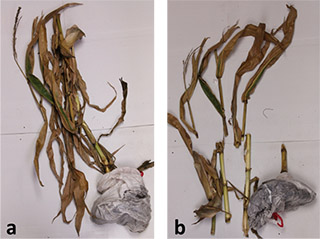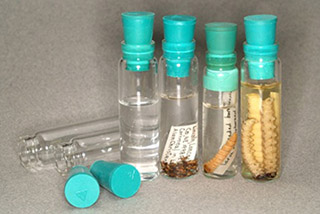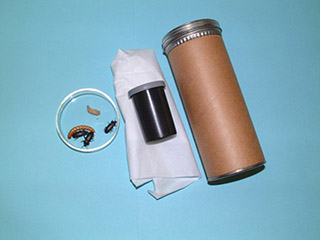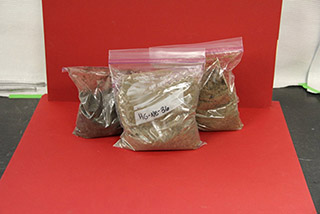G2226
Row Crops
Sample Submission to the Plant and Pest Diagnostic Clinic
Diagnoses are made easier and turnaround time is improved when sample quality is maintained. This NebGuide discusses the proper guidelines for submitting row crops to the Plant and Pest Diagnostic Clinic. A list of sample fees and the sample submission form can be found at: http://cropwatch.unl.edu/plantdiagnosticclinics.
Kevin A. Korus, Extension Educator, Plant Pathology
Tamra A. Jackson-Ziems, Extension Plant Pathologist
James A. Kalisch, Extension Associate, Entomology
Lowell D. Sandell, Extension Educator, Weed Science
- Samples for Disease Identification
- Samples for Nutrient Analysis and/or Chemical Injury
- Samples for Insect Identification
- Plant Parasitic Nematode Analysis
- Samples From Out of State
There are several important things to consider when collecting, packaging, and sending plant or insect samples for diagnosis to a plant diagnostic laboratory. The following is an outline of some helpful tips for collecting row crops, soil, weeds, or insects for sample submission. Following these guidelines will help ensure more reliable diagnoses.
Samples for Disease Identification
Collecting Samples
- Collect an adequate amount of plant material.
- When feasible, the sample should include the entire plant — leaf blights are often the result of root or crown disorders.
- The sample should include roots, stems, leaves, flowers, and fruits.
- Whole plants are needed to properly evaluate the sample.
- Include a healthy plant for comparison.
Packaging and Sending Samples
- Samples should be collected and placed in a sealable plastic bag.
- Do not collect or send samples in paper bags.
- NEVER ADD WATER TO THE BAG.
- If the plant sample is wet, you may add a dry paper towel to the sample collection bag (Figure 1).
- Enclose root ball in a separate plastic bag.
- It is OK to fold or cut plants into smaller pieces for shipping (Figure 2).
- DO NOT split stems laterally (Figure 3).
- If stalk rot is present, be sure to include the area of stem where healthy tissue meets diseased tissue (Figure 4).
- Place samples in a sturdy container for shipping.
- Send samples early in the week (Monday-Wednesday) to ensure sample quality.
- If unable to send before Wednesday, keep plants refrigerated until Monday.
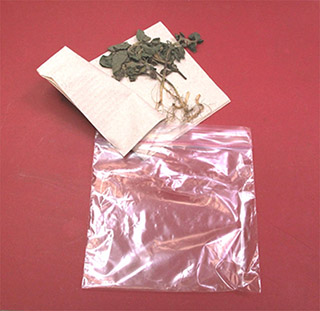 |
Figure 2. A mature corn plant properly a) folded and b) cut in preparation for shipping. |
|
Figure 1. Seedlings should be placed in a sealable plastic bag. If plants are wet, add a dry paper towel. |
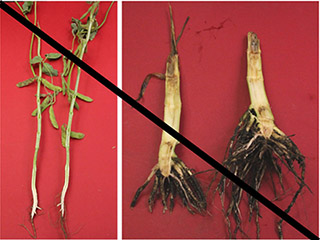 |
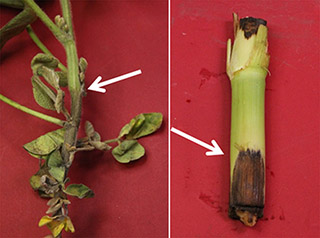 |
|
Figure 3. Plant stalks should not be cut vertically prior to shipping. |
Figure 4. Plants suffering from stem rots often have visible lesions on the outside of the stem. Collect samples from the margin of the disease lesion (white arrows). |
Sample Submission Form
Be sure to provide as much information on the sample submission form as possible.
- Describe symptom distribution on the plant (upper leaves only, lower leaves only, entire plant, etc.) and in the field.
- Specify the plant hybrid, variety, or cultivar if possible.
- Include information on the field’s history.
- Provide any additional comments that may be helpful for diagnosis.
|
Samples for Nutrient Analysis and/or Chemical Injury
Please note that the Plant and Pest Diagnostic Clinic does not provide tissue analysis testing. All diagnoses of nutrient deficiency/toxicity and chemical injury are based on visual observations of the symptomology.
Submit samples expressing injury or deficiency symptoms. Provide as much field/site history as possible including the chemical name and application dates and rates of any fertilizer, seed treatment, herbicide, fungicide or insecticide applied.
Samples for Insect Identification
Soft-bodied specimens (e.g., larvae, aphids, mites and spiders):
- Place in a tight-sealing bottle with a liquid preservative such as 70 percent alcohol or white vinegar (Figure 5).
Hard-bodied specimens (e.g., beetles, bugs, moths, ants and flies):
- Wrap in loose tissue and place in a crush-proof container (Figure 6).
Living specimens (whether soft or hard-bodied):
- Place with the host plant or damaged material along with loose paper tissue into a ventilated container.
Specimens in sticky traps and glue boards:
- Label according to location, put each in a protective bag, and mail in a crush-proof box.
Do not:
- tape specimens to paper.
- place loose insects in envelopes.
- use water or formaldehyde as a preservative.
Plant Parasitic Nematode Analysis
|
- Randomly collect about 20 cores from in and around affected area.
- Insert the soil probe at a 30-45° angle through the root zone 4-6 inches from plant.
- Combine the core samples and from this mixture, collect two cups of soil.
- Place the soil in a plastic zipper top bag (Figure 7).
- Label the bag(s).
- Do not allow the sample to freeze or get too hot.
- If possible, keep the sample refrigerated or in a cooler prior to shipping.
- Place the sample(s) in a sturdy shipping box and fill with packing material.
Samples From Out of State
Sample submission from outside of Nebraska must follow guidelines set by the United States Animal and Plant Health Inspection Service (APHIS).
If sending any plant or soil sample from outside of Nebraska, contact the University of Nebraska–Lincoln Plant and Pest Diagnostic Clinic at 402-472-2559 to receive further instruction on how to mail the sample.
This publication has been peer reviewed.
Visit the University of Nebraska–Lincoln Extension Publications website for more publications.
Index: Crop Production/Field Crops
Miscellaneous Crops
Issued January 2014
